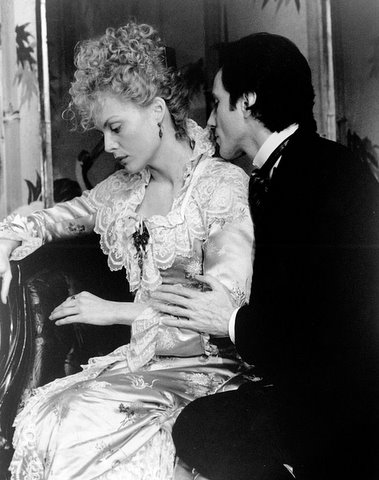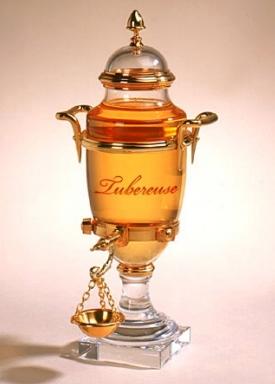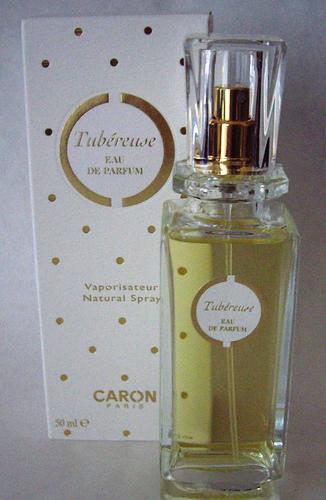Caron Tubéreuse
CONTAINED SENSUALITY
Fragrance Review
By Suzanne Keller
After dithering for the past month and a half over whether I wanted to purchase the Amouage scent for women, Epic, or a bottle of Caron Tabac Blond extrait, the Tabac Blond won out. (I still haven’t sniffed Epic yet, in case you were wondering. The verdict from all the reviews is that it’s stunning, which made the decision rather excruciating since, as you know, I’m an Amouage fan girl. But having gone through three decants of Tabac Blond over the past two years, I decided it was about time I owned a for-real bottle.) Purchasing it turned out to be a great decision, firstly, because it’s my holy grail leather scent and, secondly, because included with my purchase was a generous sample of the extrait concentration of Caron Tubéreuse.
Considering how supremely willful, unbending and diva-like tuberose is (and I say this as an enslaved lover of tuberose), then kudos, big kudos, must be extended to Richard Fraysse, Caron’s in-house perfumer, for creating a unique take on the flower that sets his scent both apart from and on the same plane with perfumery’s greatest tuberose scents: Fracas, Tubéreuse Criminelle, and Carnal Flower. Fraysse’s 2003 creation is one in which all of tuberose’s sensuality and otherworldly beauty is on display, but its haughtiness has been reined in and confined, as if its spirit has been broken a little. Exquisite beauty made vulnerable, then placed on that distinctive Caron base. (I couldn’t find a definitive list of notes for Tubéreuse, but I detect some of the familiar Mousse de Saxe base accord, comprised of geranium, licorice, leather, iodine and vanillin. What you have then is a tuberose fragrance that smells like it came out of an Edith Wharton novel—or to be more succinct, that smells like the heroine of an Edith Wharton novel, because, despite the more restrained approach to the flower, this is still, after all, a tuberose scent we’re talking about.
In its opening and middle stages of wear, Tubéreuse smells less like a soliflore than it does a Victorian tussy-mussy (a small bouquet arranged in a slim silver vase or pinned to a woman’s bodice) of tuberose surrounded by a ring of violets and violet leaves. Whether the violet component is real or imagined I’m not sure—as mentioned, it’s difficult to find a consistent list of notes for the parfum anywhere on the Internet—but that’s what I smell: tuberose blooms that are sweet and a bit candied from the violet flower, yet edged with the sharp greenness of violet leaf. The tuberose note pulsates and throbs within the scent, but its sensuality is contained by its cool confines, such that the flower’s sweetness is lilting rather than soaring; its waxiness more like the cool, silky flesh of a woman’s bare arms than of her warm heaving bosom. Think of the Countess Ellen Olenska in Wharton’s The Age of Innocence (and of actress Michelle Pfeiffer’s portrayal of the role in Martin Scorsese’s movie version of the novel): a passionate, exotic flower who once led an unconventional life in Europe, but who has been greatly humbled by a cruel marriage and the equally cruel conventions of the upper-class, New York society she has returned to after escaping the marriage. When you watch Countess Olenska in the film version—and specifically, when you observe her intimate moments with Newland Archer (played by Daniel Day-Lewis)—there is so much sensuality in her hands. The scene in the carriage where Newland Archer unbuttons her gloves and kisses her wrists…is that sexy, or what? And that’s precisely the kind of sexy this scent is about.
As it develops, Tubéreuse’s white-flower beauty is further underscored by the dark mossy base on which it sits. This base not only lends the fragrance its vintage sensibility (like an antique setting that has been readied to receive a fine new opal), but contrasted with the sweet and lightness of tuberose, it exerts a push-pull effect that makes the scent continually interesting to the nose.
The only thing that’s questionable about this tuberose perfume is whether or not I can live without it. I already own the other tuberose greats: a healthy decant of Tubéreuse Criminelle, full bottles of Carnal Flower and Fracas. Do I really need one more? For now, my wallet dictates “no,” and I shall obey. Even as I say that, though, I am reminded of Countess Olenska’s questioning of Newland Archer, early in the film, about his engagement to her cousin:
“Are you very much in love with her?” she asks him.
“As much as a man can be,” he answers.
To which she responds, “Do you think there’s a limit?”
Tubéreuse extrait de parfum can be purchased from the Caron Boutique in New York City. One of the Caron "urn perfumes," it is housed in a Louis XV-style Baccarat crystal urn and decanted into individual bottles when purchased. Prices vary according to amount.
Image: actors Michelle Pfeiffer and Daniel Day-Lewis in a scene from the 1993 film, The Age of Innocence.
Tuberose image supplied by Editor





About:
Suzanne Keller is the owner of Eiderdown Press and has her own fragrance blog called Suzanne’s Perfume Journal. Eiderdown Press is publisher of books along with the publication of Free Spirits, a coffee-table book celebrating the community of artists and other creative types in Suzanne Keller's community. Her Top 10 Favorite Fragrances: Amouage Jubilation 25, Robert Piquet Fracas, Hermes 24 Faubourg, Caron Tabac Blonde, Chanel Coromandel, Chanel No. 22, Parfums DelRae Amoureuse, Frederic Malle Carnal Flower, Parfums de Nicolai Sacrebleu, and Serge Lutens Chergui. Eiderdown Press and Suzanne’s Perfume Journal
